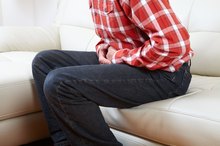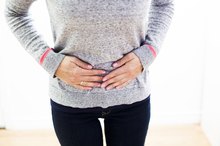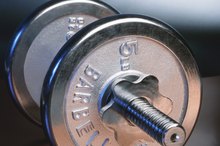Lower abdominal and groin pain can occur with many medical conditions. Possible culprits include a variety of disorders involving the digestive, musculoskeletal, reproductive and urinary systems. Some of these conditions are common while others are relatively rare -- and some are more serious than others. Accompanying signs and symptoms, and the timing, nature, progression and duration of the pain help narrow the list of possibilities, along with a thorough physical examination. Blood and imaging tests may be needed to determine the cause of lower abdominal and groin pain.
If you are experiencing serious medical symptoms, seek emergency treatment immediately.
Musculoskeletal Disorders
Several musculoskeletal problems -- those affecting the muscles, bones and related tissues -- can cause lower abdominal and groin pain. Some occur acutely, meaning they have a sudden onset, and others develop more gradually. Inflammation of the pubic bone, or osteitis pubis, characteristically causes midline lower abdominal pain that often radiates into the groin, especially while walking. This chronic overuse injury frequently occurs in runners and soccer players.
A sports hernia, or athletic pubalgia, also commonly causes slowly evolving lower abdominal and groin pain, due to weakening of the soft tissue in this area. Other possible musculoskeletal causes of lower abdominal and groin pain include: -- strain of the rectus muscle of the abdominal wall -- adductor muscle strain of the hip -- hip joint problems, such as arthritis and bursitis
- Several musculoskeletal problems -- those affecting the muscles, bones and related tissues -- can cause lower abdominal and groin pain.
- A sports hernia, or athletic pubalgia, also commonly causes slowly evolving lower abdominal and groin pain, due to weakening of the soft tissue in this area.
Abdominal Wall Hernias
Causes of Lower Abdominal & Testicular Pain
Learn More
An abdominal wall hernia describes a protrusion of abdominal organs through a weak point in the abdominal wall. Two types of abdominal wall hernias can potentially cause lower abdominal and groin pain -- inguinal and femoral hernias, both located in the groin region 3. Inguinal hernias are more common, especially in men. Both inguinal and femoral hernias manifest with a bulge in the groin.
Although most hernias cause no pain, some people experience a heavy feeling in the lower abdomen and groin, especially after prolonged standing or straining. If the bowel becomes trapped in the hernia and its blood supply cut off, progressive and severe pain can develop, signaling a medical emergency.
- An abdominal wall hernia describes a protrusion of abdominal organs through a weak point in the abdominal wall.
- Although most hernias cause no pain, some people experience a heavy feeling in the lower abdomen and groin, especially after prolonged standing or straining.
Bowel Disorders
Many bowel disorders cause lower abdominal pain that might radiate into the groin. The most immediately concerning ailment is appendicitis, which is a medical emergency. Appendicitis pain usually starts around the navel but then localizes to the lower right abdomen in most people. Accompanying symptoms may include fever, loss of appetite, nausea and vomiting. Other bowel conditions that might cause lower abdominal and groin pain include: -- diverticulitis: inflamed outpouchings of the colon -- ulcerative colitis: chronic inflammatory bowel disease -- intestinal obstruction -- ischemic colitis: colon inflammation due to decreased blood flow
- Many bowel disorders cause lower abdominal pain that might radiate into the groin.
- Appendicitis pain usually starts around the navel but then localizes to the lower right abdomen in most people.
Urinary Tract Disorders
Causes of Pain in the Lower Right Quadrant
Learn More
Some urinary tract disorders can cause lower abdominal and groin pain, often accompanied by flank pain. Kidney stones are one such disorder. These solid deposits typically trigger severe pain when they pass from the kidney into the ureter, which carries urine to the bladder. Stones in the ureter cause inflammation and can obstruct urine flow, provoking symptoms and often blood in the urine.
- Some urinary tract disorders can cause lower abdominal and groin pain, often accompanied by flank pain.
Female Reproductive Tract Disorders
Several female reproductive tract disorders can potentially cause pain in the lower abdomen and possibly the groin. Pelvic inflammatory disease (PID), an infection of the upper female reproductive tract, is one example. Ovarian cyst rupture and ovarian torsion, or twisting of the ovary, are other potential culprits of acute lower abdominal and groin pain. Ectopic pregnancy, in which a pregnancy implants outside the uterus, is another urgent consideration in women of childbearing age. Endometriosis -- a condition characterized by the growth of uterine lining tissue outside the uterus -- can cause pain in these locations, which tends to occur cyclically.
- Several female reproductive tract disorders can potentially cause pain in the lower abdomen and possibly the groin.
- Endometriosis -- a condition characterized by the growth of uterine lining tissue outside the uterus -- can cause pain in these locations, which tends to occur cyclically.
Male Reproductive Tract Disorders
Male reproductive tract disorders can also cause lower abdominal and groin pain. Testicular torsion describes twisting of the spermatic cord, which runs between the testicle and abdominal wall at the groin. This condition requires emergency medical attention as it can disrupt the blood supply to the testicle, which triggers sudden, severe, one-sided groin pain, which may be accompanied by lower abdominal pain. Other signs and symptoms include scrotal swelling, nausea and vomiting. Other male reproductive tract disorders that can potentially cause lower abdominal and groin pain include: -- epididymitis: inflammation of the epididymis, located on the back of the testicle -- orchitis: inflammation of the testicle -- prostatitis: inflammation of the prostate gland
- Male reproductive tract disorders can also cause lower abdominal and groin pain.
- This condition requires emergency medical attention as it can disrupt the blood supply to the testicle, which triggers sudden, severe, one-sided groin pain, which may be accompanied by lower abdominal pain.
Lower abdominal and groin pain should not be ignored, as this discomfort could signal a serious medical problem. In addition to the causes discussed, other conditions must also be considered, including tumors of the organ systems noted, as well as certain nerve disorders.
Reviewed and revised by: Tina M. St. John, M.D.
- Lower abdominal and groin pain should not be ignored, as this discomfort could signal a serious medical problem.
Related Articles
References
- American Family Physician: Groin Injuries in Athletes
- International Journal of Sports Physical Therapy: Athletic Pubalgia and Associated Rehabilitation
- The Ochsner Journal: The Treatment of Inguinal Pain
- Revista Dor: Abdominal Visceral Pain: Clinical Aspect
- Merck Manual Professional Version: Urinary Calculi
- Ferri's Clinical Advisor 2016: Fred F. Ferri, M.D.
- Learning Surgery: The Surgery Clerkship Manual; Stephen F. Lowry
- American Family Physician: Testicular Torsion: Diagnosis, Evaluation, and Management
- American Academy of Orthopedic Surgeons. (n.d.). Hip Fractures. https://orthoinfo.aaos.org/en/diseases--conditions/hip-fractures/
- Shetty VD, Shetty NS, Shetty AP. Groin pain in athletes: a novel diagnostic approach. SICOT J. 2015;1:16. doi:10.1051/sicotj/2015017
- Tyler TF, Silvers HJ, Gerhardt MB, Nicholas SJ. Groin injuries in sports medicine. Sports Health. 2010;2(3):231-6. doi:10.1177/1941738110366820
- Jenkins JT, O'dwyer PJ. Inguinal hernias. BMJ. 2008;336(7638):269-72. doi:10.1136/bmj.39450.428275.AD
- Chung C, Stern PJ, Dufton J. Urolithiasis presenting as right flank pain: a case report. J Can Chiropr Assoc. 2013;57(1):69-75.
- Khan AM, Mcloughlin E, Giannakas K, Hutchinson C, Andrew JG. Hip osteoarthritis: where is the pain? Ann R Coll Surg Engl. 2004;86(2):119-21. doi:10.1308/003588404322827518
- Pun S, Kumar D, Lane NE. Femoroacetabular impingement. Arthritis Rheumatol. 2015;67(1):17-27. doi:10.1002/art.38887
- Groh MM, Herrera J. A comprehensive review of hip labral tears. Curr Rev Musculoskelet Med. 2009;2(2):105-17. doi:10.1007/s12178-009-9052-9
- Moya-angeler J, Gianakos AL, Villa JC, Ni A, Lane JM. Current concepts on osteonecrosis of the femoral head.World J Orthop. 2015;6(8):590-601. doi:10.5312/wjo.v6.i8.590
- Larson CM. Sports hernia/athletic pubalgia: evaluation and management. Sports Health. 2014;6(2):139-44. doi:10.1177/1941738114523557
- Allegri M, Montella S, Salici F, et al. Mechanisms of low back pain: a guide for diagnosis and therapy. F1000Res. 2016;5. doi:10.12688/f1000research.8105.2
- Gomella P, Mufarrij P. Osteitis pubis: A rare cause of suprapubic pain. Rev Urol. 2017;19(3):156-163.
- Bisciotti GN, Auci A, Di marzo F, et al. Groin pain syndrome: an association of different pathologies and a case presentation. Muscles Ligaments Tendons J. 2015;5(3):214-22. doi:10.11138/mltj/2015.5.3.214
- American Academy of Orthopedic Surgeons. (n.d.). Hip Fractures.
- Bisciotti GN et al. Groin Pain Syndrome: An Association of Different Pathologies and a Case Presentation. Muscles Ligaments Tendons J. 2015 Jul-Sep;5(3):214-22.
- Johnson R. (2018). Approach to hip and groin pain in the athlete and active adult. Fricker P, Fields KB, eds. UpToDate. Waltham, MA: UpToDate Inc.
- Martin RR, Martin HD, Kivlan BR. Nerve Entrapment in the Hip Region: Current Concepts Review. Int J Sports Phys Ther. 2017 Dec;12(7):1163-73.
- Wilson JJ, Furukawa M. Evaluation of the Patient with Hip Pain. Am Fam Physician. 2014 Jan 1;89(1):27-34.
Writer Bio
Dr. Robert Petros has been working at the Yerevan State Medical University Department of Epidemiology and Infectious Diseases since 2009. He has had experience with thousands of patients and done a considerable amount of work in epidemic prevention on the government level.






